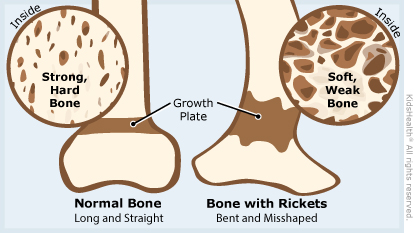Rickets
What Is Rickets?
Rickets is when a child’s bones become soft and weak. Usually, this happens because a child doesn’t get enough vitamin D. Most kids with rickets get better with treatment.
What Causes Rickets?
Kids’ bones grow when new bone tissue forms at growth plates. A growth plate is the area of growing tissue near the end of the long bones. Calcium and phosphorus attach to them so they can build strong, hard bone.
Vitamin D helps the body absorb calcium and phosphorus from food. Without enough vitamin D, the body can’t keep enough calcium and phosphorus in the growth plates. Bones stay soft and weak, and can bend or have an odd shape.

Less often, kids can develop rickets from other health conditions, like inflammatory bowel disease (IBD) or kidney problems.
What Are the Signs & Symptoms of Rickets?
As the bones start to bend and become misshaped, kids with rickets can:
- have muscle weakness or pain
- be shorter than other kids their age
- have dental problems
- break a bone
- have bow legs
How Is Rickets Diagnosed?
Doctors diagnose rickets by:
- doing an exam, checking bones for tenderness or pain by pressing on them
- ordering blood tests to check calcium, phosphorus, and vitamin D levels
- getting X-rays to look for bone deformities (when bones are bent or misshaped)
How Is Rickets Treated?
Treatment for rickets helps make bones stronger. Doctors prescribe supplements to replace the missing vitamin D, calcium, and phosphorus.
Kids with a bone deformity might need braces to reposition the bones as they grow. In severe cases, a child may need surgery.
If another disease causes rickets, a child will go to a specialist for care.
Can Rickets Be Prevented?
The time to build strong bones is when we’re kids and teens. Children who start their adult lives with the strongest bones possible are less likely to have bone loss later in life.
That’s why getting enough calcium and vitamin D is so important. To help your kids build healthy bones:
- Serve high-calcium foods: Calcium-rich foods include dairy products, beans, some nuts and seeds, and leafy green vegetables. It’s also often added to foods like orange juice or cereal. Buy high-calcium versions of common foods, like almond butter instead of peanut butter or calcium-fortified orange juice instead of regular juice.
- Make sure kids get enough vitamin D: Most kids don’t eat many foods that naturally contain vitamin D, like fatty fish. But other foods are fortified with vitamin D, such as milk and cereal. A children’s over-the-counter multivitamin also can help kids get enough vitamin D.
- Use careful sun exposure: Our bodies make vitamin D when skin is exposed to sunlight. Exposing the hands and face to sunlight a few times a week during the spring and summer can help prevent rickets. But it’s important to keep the exposure brief, and to protect skin with sunscreen to prevent melanoma and skin damage.
- Encourage kids to exercise: Bones get stronger the more we use them. Weight-bearing activities like walking, running, jumping, and climbing are especially good for building bone.
How Can Parents Help?
If your child has rickets:
- Give your child any supplements as directed by the doctor.
- Follow the instructions for how much sun exposure your child should have. Your child should always wear sunscreen of SPF 30 or higher when in the sun.
- Go to all follow-up visits so the doctor can recheck your child’s blood work.
- Talk with a registered dietitian about which foods can help your child build strong bones.
Call the doctor if your child:
- has bone or muscle pain that’s new or gets worse
- has muscle spasms
- develops new symptoms
Go the ER if your child:
- has a seizure, which can sometimes happen when calcium or phosphorus levels are very low
- breaks a bone
